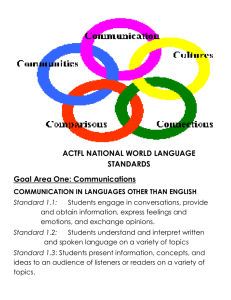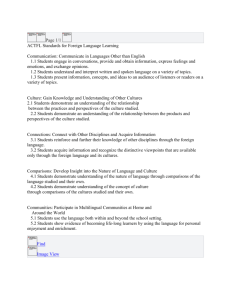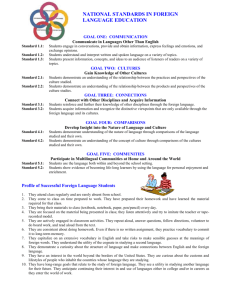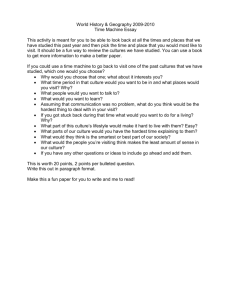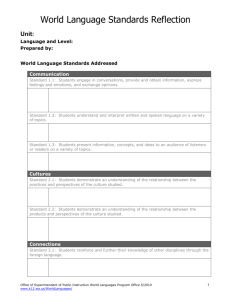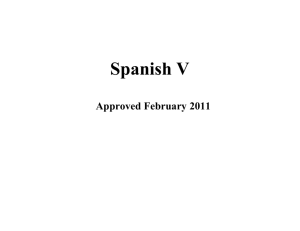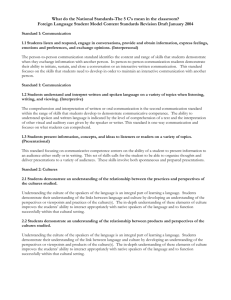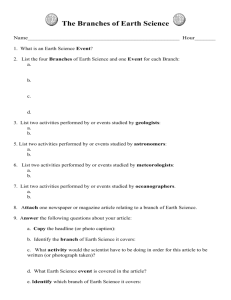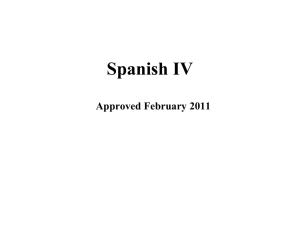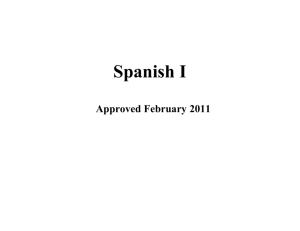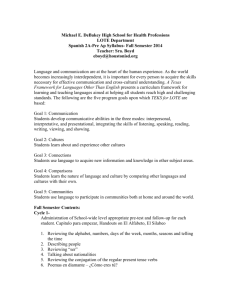Spanish II
advertisement
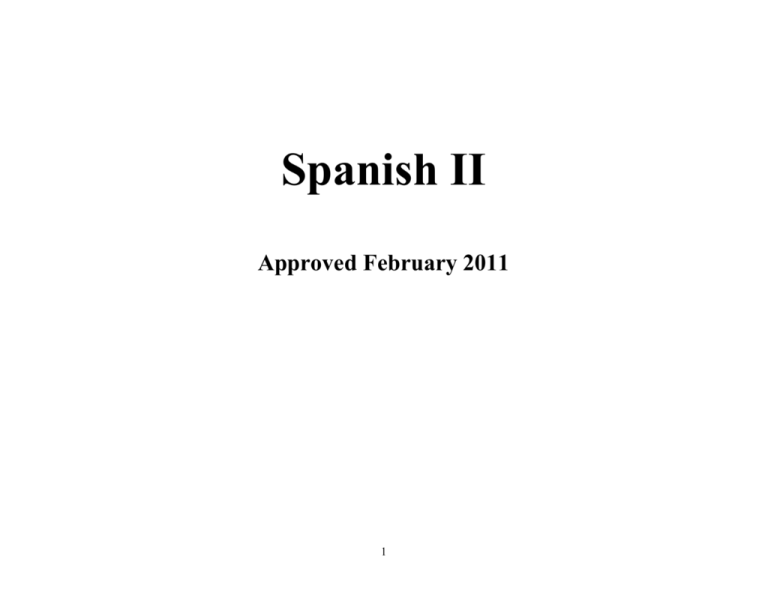
Spanish II Approved February 2011 1 Unit 1: 5A: Una fiesta de cumpleaños (A Birthday Party) Essential Understandings: 1. Communicate in languages other than English 2. Gain knowledge and understanding of other cultures 3. Connect with other disciplines and acquire information 4. Develop insights into the nature of language and culture 5. Participate in multilingual communities at home and around the world Content Standards: 1.1: Students engage in conversations, provide and obtain information, express feelings and emotions, and exchange opinions. 1.2: Students understand and interpret written and spoken language in a variety of topics 1.3: Students present information, concepts, and ideas to an audience of listeners or readers on a variety of topics. 2.1: Students demonstrate an understanding of the relationship between the practices and perspectives of the culture studied. 2.2: Students demonstrate and understanding of the relationship between the products and perspectives of the culture studied. 3.1: Students reinforce and further their knowledge of other disciplines through the foreign language. 3.2: Students acquire information and recognize the distinctive viewpoints that are only available through the foreign language and its cultures. 4.1: Students demonstrate understanding of the nature of language through comparison of the language studied and their own. 4.2: Students demonstrate understanding of the concept of culture through comparisons and the cultures studied and their own. 5.1: Students use the language both within and beyond the school setting. 5.2: Students show evidence of becoming life-long learners by using the language for personal enjoyment and enrichment. Essential Question: How do we describe family relationships and celebrations? Learning Goals: Students will: Read, listen to and explain information about families, parties and celebrations Communicate about families and parties Use the verb “tener” to ask and tell what people have Use the verb “tener” to ask and tell people’s ages Use the possessive adjectives to tell to whom something belongs Compare and contrast birthday celebrations in the U.S. and Latin America 2 Suggested Strategies Suggested Assessments Suggested Resources Suggested Tech Integration Content Vocabulary Lifelong Learning/21st Century Skills Flashcards with clip art Mime and charades Partner interviews/conversations Listening comprehension activities Dice game for conjugations Vocubes Memory game BINGO Tests Quizzes Chapter Project Whiteboards Informal Daily Assessments Projects Create a personalized family album or tree Realidades 1 Textbook Realidades 1 Practice Workbook Realidades 1 Teacher’s Resources English/Spanish dictionary Videohistoria Sweet 15 video GramActiva video Realidades 1 Audio Program Microsoft PowerPoint Class webpage Mi Vida Loca video series Family members Possessive adjectives Celebration related vocabulary Productive habits of mind Quality work Read critically Communicate effectively Access and process information Core Ethical Values 3 Course: Spanish II Unit 2: 5B: ¡Vamos a un restaurante! (Let’s Go to a Restaurant!) Essential Understandings: 1. Communicate in languages other than English 2. Gain knowledge and understanding of other cultures 3. Connect with other disciplines and acquire information 4. Develop insights into the nature of language and culture 5. Participate in multilingual communities at home and around the world Content Standards: 1.1: Students engage in conversations, provide and obtain information, express feelings and emotions, and exchange opinions. 1.2: Students understand and interpret written and spoken language in a variety of topics 1.3: Students present information, concepts, and ideas to an audience of listeners or readers on a variety of topics. 2.1: Students demonstrate an understanding of the relationship between the practices and perspectives of the culture studied. 2.2: Students demonstrate and understanding of the relationship between the products and perspectives of the culture studied. 3.1: Students reinforce and further their knowledge of other disciplines through the foreign language. 3.2: Students acquire information and recognize the distinctive viewpoints that are only available through the foreign language and its cultures. 4.1: Students demonstrate understanding of the nature of language through comparison of the language studied and their own. 4.2: Students demonstrate understanding of the concept of culture through comparisons and the cultures studied and their own. 5.1: Students use the language both within and beyond the school setting. 5.2: Students show evidence of becoming life-long learners by using the language for personal enjoyment and enrichment. Essential Questions: How do we order in a restaurant? How do we describe people using physical characteristics? Learning Goals: Students will: Read, listen to, and explain information about descriptions of family members, restaurant vocabulary, and table settings Describe people and foods Order a meal at a restaurant Use the verb “venir” Use the verbs “ser” and “estar” Express needs at a restaurant Compare and contrast physical characteristics of famous people 4 Suggested Strategies Suggested Assessments Suggested Resources Suggested Tech Integration Content Vocabulary Lifelong Learning/21st Century Skills Flashcards with clip art Mime and charades Partner interviews/conversations Listening comprehension activities Dice game for conjugations Vocubes Memory game BINGO Club de Cien Tests Quizzes Chapter Project Whiteboards Informal Daily Assessments Projects Create a skit about eating out in a restaurant Realidades 1 Textbook Realidades 1 Practice Workbook Realidades 1 Teacher’s Resources English/Spanish dictionary Videohistoria GramActiva iMovie Mi Vida Loca video series LCD projector Class website Physical descriptions Vocabulary for ordering in a restaurante Table settings Expressing needs Productive habits of mind Quality work Read critically Communicate effectively Collaborate and cooperate Core Ethical Values 5 Unit 3: 6A: En mi dormitorio (In my Bedroom) Essential Understandings: 1. Communicate in languages other than English 2. Gain knowledge and understanding of other cultures 3. Connect with other disciplines and acquire information 4. Develop insights into the nature of language and culture 5. Participate in multilingual communities at home and around the world Content Standards: 1.1: Students engage in conversations, provide and obtain information, express feelings and emotions, and exchange opinions. 1.2: Students understand and interpret written and spoken language in a variety of topics 1.3: Students present information, concepts, and ideas to an audience of listeners or readers on a variety of topics. 2.1: Students demonstrate an understanding of the relationship between the practices and perspectives of the culture studied. 2.2: Students demonstrate and understanding of the relationship between the products and perspectives of the culture studied. 3.1: Students reinforce and further their knowledge of other disciplines through the foreign language. 3.2: Students acquire information and recognize the distinctive viewpoints that are only available through the foreign language and its cultures. 4.1: Students demonstrate understanding of the nature of language through comparison of the language studied and their own. 4.2: Students demonstrate understanding of the concept of culture through comparisons and the cultures studied and their own. 5.1: Students use the language both within and beyond the school setting. 5.2: Students show evidence of becoming life-long learners by using the language for personal enjoyment and enrichment. Essential Question: How do we describe items in our bedroom? Learning Goals: Students will: Read, listen to and explain information about bedroom items, electronic equipment and colors Name items found in a bedroom Discuss electronic equipment Use colors to describe things Use comparatives and superlatives Use the verbs “poder” and “dormir” 6 Suggested Strategies Suggested Assessments Suggested Resources Suggested Tech Integration Content Vocabulary Lifelong Learning/21st Century Skills Flashcards with clip art Mime and charades Partner interviews/conversations Listening comprehension activities Dice game for conjugations Vocubes Memory game BINGO Tests Quizzes Chapter Project Whiteboards Informal Daily Assessments Projects Create a model/poster highlighting items in their bedroom Realidades 1 Textbook Realidades 1 Practice Workbook Realidades 1 Teacher’s Resources English/Spanish dictionary Videohistoria GramActiva Mi Vida Loca video series Class website LCD projector Bedroom furniture and electronics Colors Comparing and contrasting Descriptive adjectives Productive habits of mind Quality work Read critically Communicate effectively Access and process information Core Ethical Values 7 Unit 4: 6B: ¿Cómo es tu casa? (What is Your House Like?) Essential Understandings: 1. Communicate in languages other than English 2. Gain knowledge and understanding of other cultures 3. Connect with other disciplines and acquire information 4. Develop insights into the nature of language and culture 5. Participate in multilingual communities at home and around the world Content Standards: 1.1: Students engage in conversations, provide and obtain information, express feelings and emotions, and exchange opinions. 1.2: Students understand and interpret written and spoken language in a variety of topics 1.3: Students present information, concepts, and ideas to an audience of listeners or readers on a variety of topics. 2.1: Students demonstrate an understanding of the relationship between the practices and perspectives of the culture studied. 2.2: Students demonstrate and understanding of the relationship between the products and perspectives of the culture studied. 3.1: Students reinforce and further their knowledge of other disciplines through the foreign language. 3.2: Students acquire information and recognize the distinctive viewpoints that are only available through the foreign language and its cultures. 4.1: Students demonstrate understanding of the nature of language through comparison of the language studied and their own. 4.2: Students demonstrate understanding of the concept of culture through comparisons and the cultures studied and their own. 5.1: Students use the language both within and beyond the school setting. 5.2: Students show evidence of becoming life-long learners by using the language for personal enjoyment and enrichment. Essential Question: What is your house like? Learning Goals: Students will: Read, listen to, and explain information about rooms in a house, household chores and how to tell someone to do something Talk about the rooms of the house Talk about the chores around the house Use the familiar “tú” commands Use the present progressive tense Compare and contrast houses in the U.S. and Latin America 8 Suggested Strategies Suggested Assessments Suggested Resources Suggested Tech Integration Content Vocabulary Lifelong Learning/21st Century Skills Flashcards with clip art Mime and charades Partner interviews/conversations Listening comprehension activities Dice game for conjugations Vocubes Memory game BINGO Tests Quizzes Chapter Project Whiteboards Informal Daily Assessments Projects Create a flyer to sell a house or apartment Realidades 1 Textbook Realidades 1 Practice Workbook Realidades 1 Teacher’s Resources English/Spanish dictionary Videohistoria GramActiva Mi Vida Loca video series Class website LCD projector Rooms in the house Chores Productive habits of mind Quality work Read critically Communicate effectively Collaborate and cooperate Access and process information Core Ethical Values 9 Unit 5: 7A: ¿Cuánto cuesta? (How Much does it Cost?) Essential Understandings: 1. Communicate in languages other than English 2. Gain knowledge and understanding of other cultures 3. Connect with other disciplines and acquire information 4. Develop insights into the nature of language and culture 5. Participate in multilingual communities at home and around the world Content Standards: 1.1: Students engage in conversations, provide and obtain information, express feelings and emotions, and exchange opinions. 1.2: Students understand and interpret written and spoken language in a variety of topics 1.3: Students present information, concepts, and ideas to an audience of listeners or readers on a variety of topics. 2.1: Students demonstrate an understanding of the relationship between the practices and perspectives of the culture studied. 2.2: Students demonstrate and understanding of the relationship between the products and perspectives of the culture studied. 3.1: Students reinforce and further their knowledge of other disciplines through the foreign language. 3.2: Students acquire information and recognize the distinctive viewpoints that are only available through the foreign language and its cultures. 4.1: Students demonstrate understanding of the nature of language through comparison of the language studied and their own. 4.2: Students demonstrate understanding of the concept of culture through comparisons and the cultures studied and their own. 5.1: Students use the language both within and beyond the school setting. 5.2: Students show evidence of becoming life-long learners by using the language for personal enjoyment and enrichment. Essential Question: How do we shop for clothing? Learning Goals: Students will: Read, listen to and explain information about shopping for clothes Use the verbs “pensar”, “querer” and “preferir” Talk about shopping for clothes Discuss how clothes fit and how much they cost(in euros, Mexican pesos and dollars) Point things out using demonstrative adjectives Use numbers in the hundreds 10 Suggested Strategies Suggested Assessments Suggested Resources Suggested Tech Integration Content Vocabulary Lifelong Learning/21st Century Skills Flashcards with clip art Mime and charades Partner interviews/conversations Listening comprehension activities Dice game for conjugations Vocubes Memory game BINGO Bag of clothing for interactive activities Tests Quizzes Chapter Project Whiteboards Informal Daily Assessments Projects Create and perform a skit about shopping for clothes Realidades 1 Textbook Realidades 1 Practice Workbook Realidades 1 Teacher’s Resources English/Spanish dictionary Videohistoria GramActiva Mi Vida Loca video series Class website LCD projector Clothing items Numbers in the hundreds Demonstrative adjectives Shopping vocabulary Productive habits of mind Quality work Read critically Communicate effectively Collaborate and cooperate Core Ethical Values 11 Unit 6: 7B: ¡Qué regalo! (What a gift!) Essential Understandings: 1. Communicate in languages other than English 2. Gain knowledge and understanding of other cultures 3. Connect with other disciplines and acquire information 4. Develop insights into the nature of language and culture 5. Participate in multilingual communities at home and around the world Content Standards: 1.1: Students engage in conversations, provide and obtain information, express feelings and emotions, and exchange opinions. 1.2: Students understand and interpret written and spoken language in a variety of topics 1.3: Students present information, concepts, and ideas to an audience of listeners or readers on a variety of topics. 2.1: Students demonstrate an understanding of the relationship between the practices and perspectives of the culture studied. 2.2: Students demonstrate and understanding of the relationship between the products and perspectives of the culture studied. 3.1: Students reinforce and further their knowledge of other disciplines through the foreign language. 3.2: Students acquire information and recognize the distinctive viewpoints that are only available through the foreign language and its cultures. 4.1: Students demonstrate understanding of the nature of language through comparison of the language studied and their own. 4.2: Students demonstrate understanding of the concept of culture through comparisons and the cultures studied and their own. 5.1: Students use the language both within and beyond the school setting. 5.2: Students show evidence of becoming life-long learners by using the language for personal enjoyment and enrichment. Essential Question: How do we shop for gifts and accessories? Learning Goals: Students will: Read, listen to and explain information about stores, shopping for gifts and accessories and things done in the past Talk about stores and where they are located Ask and tell about shopping and buying Talk about the past, using the preterit of –ar verbs including –car and -gar Use the direct object pronouns(lo, la, los, las) 12 Suggested Strategies Suggested Assessments Suggested Resources Suggested Tech Integration Content Vocabulary Lifelong Learning/21st Century Skills Read about shopping in four Hispanic communities in the U.S. Flashcards with clip art Mime and charades Partner interviews/conversations Listening comprehension activities Dice game for conjugations Vocubes Memory game BINGO Tests Quizzes Chapter Project Whiteboards Informal Daily Assessments Projects Virtually purchase gifts from Spanish websites (such as corteingles.com) and create a compilation of purchased items Realidades 1 Textbook Realidades 1 Practice Workbook Realidades 1 Teacher’s Resources English/Spanish dictionary Videohistoria GramActiva Mi Vida Loca video series Class website LCD projector ¿Eres tú María? video series Store vocabulary Gifts and accessories Past tense markers Productive habits of mind Quality work Read critically Communicate effectively Collaborate and cooperate Access and process information Core Ethical Values 13 Unit 7: 8A: De vacaciones (On Vacation) Essential Understandings: 1. Communicate in languages other than English 2. Gain knowledge and understanding of other cultures 3. Connect with other disciplines and acquire information 4. Develop insights into the nature of language and culture 5. Participate in multilingual communities at home and around the world Content Standards: 1.1: Students engage in conversations, provide and obtain information, express feelings and emotions, and exchange opinions. 1.2: Students understand and interpret written and spoken language in a variety of topics 1.3: Students present information, concepts, and ideas to an audience of listeners or readers on a variety of topics. 2.1: Students demonstrate an understanding of the relationship between the practices and perspectives of the culture studied. 2.2: Students demonstrate and understanding of the relationship between the products and perspectives of the culture studied. 3.1: Students reinforce and further their knowledge of other disciplines through the foreign language. 3.2: Students acquire information and recognize the distinctive viewpoints that are only available through the foreign language and its cultures. 4.1: Students demonstrate understanding of the nature of language through comparison of the language studied and their own. 4.2: Students demonstrate understanding of the concept of culture through comparisons and the cultures studied and their own. 5.1: Students use the language both within and beyond the school setting. 5.2: Students show evidence of becoming life-long learners by using the language for personal enjoyment and enrichment. Essential Question: How do we describe vacations in the past? Learning Goals: Students will: Read, listen to and explain information about travel and vacations and past events Talk about vacations and trips Talk about places to visit and how to get there Use preterit tense of –er and –ir verbs Use preterit of “ir” Use the personal “a” 14 Suggested Strategies Suggested Assessments Suggested Resources Suggested Tech Integration Content Vocabulary Lifelong Learning/21st Century Skills Read a journal about a trip to Peru Flashcards with clip art Mime and charades Partner interviews/conversations Listening comprehension activities Dice game for conjugations Vocubes Memory game BINGO Tests Quizzes Chapter Project Whiteboards Informal Daily Assessments Projects Describe a trip they have taken Create a PowerPoint or podcast describing a vacation they have taken Realidades 1 Textbook Realidades 1 Practice Workbook Realidades 1 Teacher’s Resources English/Spanish dictionary Videohistoria GramActiva Mi Vida Loca video series Class website LCD projector ¿Eres tú María? video series PowerPoint presentation Audacity podcast recordings Places to visit on vacation Things we see and do on vacation Modes of transportation Productive habits of mind Quality work Read critically Communicate effectively Collaborate and cooperate 15 Access and process information Core Ethical Values 16 Unit 8: 8B: Ayudando en la comunidad (Helping in the Community) Essential Understandings: 1. Communicate in languages other than English 2. Gain knowledge and understanding of other cultures 3. Connect with other disciplines and acquire information 4. Develop insights into the nature of language and culture 5. Participate in multilingual communities at home and around the world Content Standards: 1.1: Students engage in conversations, provide and obtain information, express feelings and emotions, and exchange opinions. 1.2: Students understand and interpret written and spoken language in a variety of topics 1.3: Students present information, concepts, and ideas to an audience of listeners or readers on a variety of topics. 2.1: Students demonstrate an understanding of the relationship between the practices and perspectives of the culture studied. 2.2: Students demonstrate and understanding of the relationship between the products and perspectives of the culture studied. 3.1: Students reinforce and further their knowledge of other disciplines through the foreign language. 3.2: Students acquire information and recognize the distinctive viewpoints that are only available through the foreign language and its cultures. 4.1: Students demonstrate understanding of the nature of language through comparison of the language studied and their own. 4.2: Students demonstrate understanding of the concept of culture through comparisons and the cultures studied and their own. 5.1: Students use the language both within and beyond the school setting. 5.2: Students show evidence of becoming life-long learners by using the language for personal enjoyment and enrichment. Essential Question: How do you help in the community? Learning Goals: Students will: Read, listen to and explain information about volunteer work, community service tasks and what people did to help others Talk about helping their community Ask and tell about recycling and volunteering Use the present tense of “decir” and the preterit tense of “hacer” and “dar” Use indirect object pronouns 17 Suggested Strategies Suggested Assessments Suggested Resources Suggested Tech Integration Content Vocabulary Lifelong Learning/21st Century Skills Flashcards with clip art Mime and charades Partner interviews/conversations Listening comprehension activities Dice game for conjugations Vocubes Memory game BINGO Tests Quizzes Chapter Project Whiteboards Informal Daily Assessments Projects Realidades 1 Textbook Realidades 1 Practice Workbook Realidades 1 Teacher’s Resources English/Spanish dictionary Videohistoria GramActiva Mi Vida Loca video series Class website LCD projector ¿Eres tú María? video series Recycling vocabulary Places in the community Volunteer work vocabulary Productive habits of mind Quality work Read critically Communicate effectively Collaborate and cooperate Core Ethical Values 18
